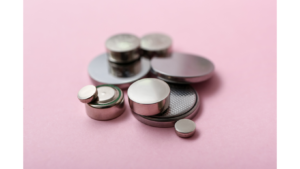The Dangers of Button Batteries: Accidental swallowing or ingesting button batteries can cause potentially severe injuries in small children.
Learn more on preventing an accident involving button batteries and how to provide first aid when necessary.
Button Batteries
Button Batteries are small, often flat tiny batteries found in toys and other household appliances and products. They operate remote controls, car keys, and small electronic devices like calculators and weighing scales.

Due to batteries being tiny, it makes them the perfect size for children to pop in their mouth, nose, and ear. Although swallowing a button battery may not lead to choking, it can do some severe internal damage. When mixed with saliva, the electrical current from the battery can produce harmful acids which can burn through the throat or stomach. If left for a certain period, it can cause further damage to other internal organs.
Button batteries are high risk for children. Watch out for any signs of ingesting, swallowing, or poisoning symptoms from these small but deadly items.
Signs and Symptoms
Here are some signs to look for if the child swallows or ingests a button battery.
- Vomiting fresh and bright red blood
- Sudden development of cough, or may gag and drooling a lot
- Having an upset stomach
- Blood in stool
- Different mouth taste due to discharge of chemicals from the battery
- Severe burning and pain in the throat and food-pipe (esophagus)
- Swollen stomach and intestines
- Chest pain
- Cardiovascular shock
- Being tired or lethargic
- Losing their appetite or having a reduced appetite
First Aid Treatment
If you suspect a child has swallowed a button battery, call an ambulance or take them to the nearest emergency room.
Here are first-aid steps to follow:
- Seek immediate help
Call Triple Zero (000), Australia’s national hotline for emergency services (police, fire, ambulance). Another option is to call Poison Control at 131 126 or go to the nearest local emergency department. Bring the battery package or matching battery if possible.
- Do not wait for symptoms.
Prompt action is critical in this emergency. Do not wait for symptoms to develop before seeking medical help.
- Keep the person safe.
Do not induce vomiting and do not give food or drinks until the X-ray is clear.
Do not let the person eat or drink until an X-ray is complete.
- Remove the batteries
Quickly remove batteries stuck inside the food pipe or stomach. If left for 2 hours, it can quickly cause severe damage.
Take out the batteries in the nose or ear to avoid permanent damage.
- Follow up
The doctors may require an X-ray after 48 hours to ensure no battery remains inside the child’s body. The following steps will depend on the X-ray results.
Prevention
Here are a few things to do to prevent ingesting or swallowing these small, harmful items.
- Never leave batteries sitting out where children can see them. Store spare batteries in a location that is out of the sight and reach of the kids.
- Secure shut battery compartments in all household devices.
- Do not allow small children to play with any-battery powered producers that are easy to pop out.
- Never put batteries in your mouth for any reason. Batteries are slippery and easily swallowed.
- If there is a hearing aid in the household, keep them safe away from the children.
- Do not insert or replace batteries in front of small children.
Conclusion
Parents, teachers, and babysitters need to be aware of the danger of button batteries at home or school. Do the following prevention tips above and know what to do if they do manage to ingest one. Learn more about childcare and safety.
There is no substitute for first aid learning. Learn (CPR) and the age-appropriate Heimlich maneuver to be ready in child-related emergencies.
Visit First Aid Courses Darwin for more information.








